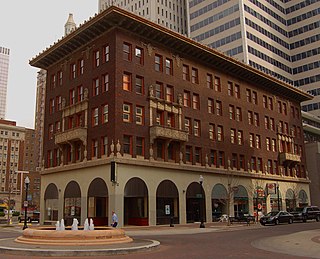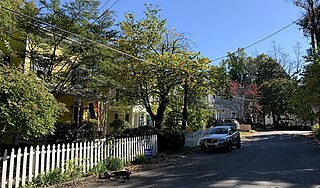
Sears, Roebuck and Co., commonly known as Sears, is an American chain of department stores founded in 1892 by Richard Warren Sears and Alvah Curtis Roebuck and reincorporated in 1906 by Richard Sears and Julius Rosenwald, with what began as a mail ordering catalog company migrating to opening retail locations in 1925, the first in Chicago. In 2005, the company was bought by the management of the American big box discount chain Kmart, which upon completion of the merger, formed Sears Holdings. Through the 1980s, Sears was the largest retailer in the United States. In 2018, it was the 31st-largest. After several years of declining sales, Sears's parent company filed for Chapter 11 bankruptcy on October 15, 2018. It announced on January 16, 2019, that it had won its bankruptcy auction, and that a reduced number of 425 stores would remain open, including 223 Sears stores.

Tenleytown is a historic neighborhood in Northwest, Washington, D.C.

Western Auto Supply Company—known more widely as Western Auto—was a specialty retail chain of stores that supplied automobile parts and accessories. It operated approximately 1200 stores across the United States. It was started in 1909 in Kansas City, Missouri, by George Pepperdine and Don Abnor Davis. Pepperdine later founded Pepperdine University. Western Auto was bought by Beneficial Corporation in 1961; Western Auto's management led a leveraged buyout in 1985, leading three years later to a sale to Sears. Sears sold most of the company to Advance Auto Parts in 1998, and by 2003, the resulting merger had led to the end of the Western Auto brand and its product distribution network.
Miller's Department Store was a chain of department stores based in East Tennessee.

The Midtown Exchange is a historic structure and mixed-use building located in the Midtown neighborhood of Minneapolis, Minnesota, United States. It is the second-largest building in Minnesota in terms of leasable space, after the Mall of America. It was built in 1928 as a retail and mail-order catalog facility for Sears, which occupied it until 1994. It lay vacant until 2005, when it was transformed into multipurpose commercial space. The building is listed on the National Register of Historic Places as the Sears, Roebuck and Company Mail-Order Warehouse and Retail Store.

The Landmark Center or 401 Park Building in Boston, Massachusetts is a commercial center situated in a limestone and brick art deco building built in 1928 for Sears, Roebuck and Company. It features a 200-foot-tall (61 m) tower and, as Sears Roebuck and Company Mail Order Store, it is listed on the National Register of Historic Places and designated as a Boston Landmark in 1989.
There are more than 350 places listed on the United States National Register of Historic Places in Chicago, Illinois, including 83 historic districts that may include numerous historic buildings, structures, objects and sites. This total is documented in the tables referenced below. Tables of these listings may be found in the following articles:

The Immaculata Seminary Historic District, commonly known as Tenley Campus, is an 8.2-acre (3.3 ha) parcel of land, located off of Tenley Circle in the Northwest Washington, D.C. neighborhood of Tenleytown. The site of Dunblane, an early to mid-nineteenth-century Federal/Greek Revival-style manor house, it was once part of a large country estate on the outskirts of the capital city, owned by a succession of prominent Georgetown residents. From 1904 to 1906, the land was acquired by the Catholic Sisters of Providence of Saint Mary-of-the-Woods, who, for decades, operated all-girls primary, secondary, and postsecondary schools there under the Immaculata name, before being forced to shutter due to financial issues. Since 1986, it has been a satellite campus of American University, which purchased the site in part because of its proximity to Tenleytown station on the Red Line of the Washington Metro. It currently houses the school's Washington College of Law.

The Sears, Roebuck and Company Complex is a building complex in the community area of North Lawndale in Chicago, Illinois. The complex hosted most of department-store chain Sears' mail order operations between 1906 and 1993, and it also served as Sears' corporate headquarters until 1973, when the Sears Tower was completed. Of its original 40-acre (16 ha) complex, only three buildings survive and have been adaptively rehabilitated to other uses. The complex was designated a National Historic Landmark in 1978, at which time it still included the 3,000,000-square-foot mail order plant, the world's largest commercial building when it was completed. That building has been demolished, its site taken up by the Homan Square redevelopment project.

The Sears, Roebuck & Company product distribution center in Boyle Heights, Los Angeles, California, is a historic landmark that was one of the company's mail-order facilities, with a retail store on the ground floor.
Sears, Roebuck and Company Department Store or
Sears Roebuck and Company Mail Order Store or
Sears, Roebuck & Company Mail Order Building or
Sears, Roebuck and Company Warehouse Building or variations may refer to:

The Sears, Roebuck and Company Department Store in Miami, Florida was an Art Deco building built in 1929 for Sears, Roebuck and Company. The building was the first known implementation of Art Deco architecture in the county and was spectacular. It was followed a year later by the Shrine Building, an application of Art Deco with local Seminole Indian motifs added as an interesting twist. Both were covered in a 1988 study of Downtown Miami historic resources, but were not NRHP-listed due to owner objections at the time. It was listed on the National Register of Historic Places on August 8, 1997. Only its tower remains.


The Sears, Roebuck and Company Retail Department Store Building in Camden, Camden County, New Jersey, United States, was built in 1927 and housed a Sears department store until 1971, when the store relocated to Moorestown Mall. It was South Jersey's first free-standing department store. It was also among the first department stores to be built with its own parking lot, a precursor to the modern shopping mall. It was added to the National Register of Historic Places on July 27, 2000.

The Siegel-Cooper Company was a department store that opened in Chicago in 1887 and expanded into New York City in 1896. At the time of its opening, the New York store was the largest in the world.

The McFarlin Building is a general office building located on the northeast corner of Fifth Street and Main in downtown Tulsa, Oklahoma. The five-story building was built in 1918 by Barnett, Haynes & Barnett for oilman Robert M. McFarlin, and is on the National Register of Historic Places. It is also a contributing property for the Oil Capital Historic District.

The Grant Road Historic District is located in the Tenleytown neighborhood of Washington, D.C. The two-block historic district is what remains of a former settlement in rural Washington County in the District of Columbia. It includes 13 contributing buildings and the road itself, a narrow remnant of a country road that was used by soldiers in the Civil War. Following the war, the road was named after Civil War general and President Ulysses S. Grant. Grant Road developed into a residential street lined with mostly small, two-story homes for working-class people.

The Gimbels Parking Pavilion is an Art Moderne-style parking ramp built by Gimbels Department Store for its customers in Milwaukee, Wisconsin in 1947. It was added to the National Register of Historic Places in 2001.

Memorial Mall is a former indoor shopping mall located in Sheboygan, Wisconsin, since redeveloped and anchored by a new Meijer hypermarket. Opened in 1969, it currently features Kohl's and four other smaller stores in the former south mall wing, with three additional stores within the Meijer space.
Pico/Rimpau is an area of Mid-City, Los Angeles, at the junction of Pico Boulevard, Rimpau Street, San Vicente Boulevard, Venice Boulevard, Vineyard Avenue and West Boulevard. This area is the location of several key former and current transportation hubs and retail shopping centers for the Los Angeles area.


















